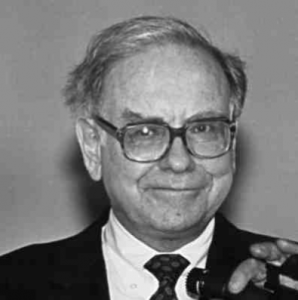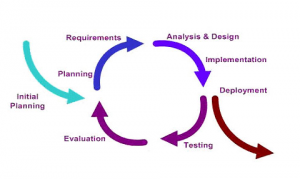 In the 1950s, a young man enrolled in a public speaking course “not to prevent my knees from knocking when public speaking, but to do public speaking while my knees are knocking.” That young man was Warren Buffet, now one of the world’s richest men.
In the 1950s, a young man enrolled in a public speaking course “not to prevent my knees from knocking when public speaking, but to do public speaking while my knees are knocking.” That young man was Warren Buffet, now one of the world’s richest men.
The course was a Dale Carnegie (author of the multi-million bestseller ‘How to Win Friends and Influence People) public speaking course and the investment he made was $100. Warren Buffet has many admirable qualities and a number of habits that contribute to his enormous financial success.
 Warren Buffet, after he learned to speak whilst his knees knocked
Warren Buffet, after he learned to speak whilst his knees knocked
My personal belief is that a crucial aspect of his success is his adaptability over his many years in business and, in turn, his resilience. Resilience has become something of a popular topic in recent years, discussed in the contexts of governments and policy-making, organisational change and of course that of the individual. The two definitions in the Oxford Dictionary of resilience are:
“The ability of a substance or object to bounce back into shape; elasticity.” and “The capacity to recover quickly from difficulties; toughness.”
Adaptability, therefore, is intrinsic to resilience and ipso facto, as I think most of us would find it hard to dispute, resilience is crucial for an individual’s survival. As individuals make up organisations, communities and countries, and it is individuals who read SpeakUp! Journals, I want to focus my attention on the individual in this article.
Let’s face it, a large number of us have had to dig deep since 2008, during what is now aptly-called the Great Recession. Lasting far longer than originally predicted, those individuals who have survived – thrived even – are the ones with the most ability to bounce back and adapt to the new world. I appreciate that adaptability is only one aspect of a set of survival skills and that our survival is of course dependent on a number of external as well as internal factors. However, for the purposes of this article and its usefulness to you as the reader, I’m going to concentrate on this skill.
In their award-winning book ‘Why Change Doesn’t Work’, clinical psychologist Harvey Robbins and journalist Michael Finley provide practical and proven methods for managers to work with human nature, not against it. Too often this has not been the method for effecting change, whether by governments or organisations. They would assert this is why change doesn’t (usually) work. To develop and use the internal forces that help overcome adversity and challenges, we need to build capability and competence. It would be wonderful if we could simply adapt and gain the knowledge and skills we need to acquire with a simple wave of a magic wand.
Unfortunately, we don’t. People need training and education which then has to be put into practise over a period of time to build that capability and competence. If we embrace what The Royal Society of Arts and Manufacture call the ‘power to create’, a model of change that starts from people taking action, we don’t necessarily need to feel victims of the whims and vagaries of politicians and economists. As Matthew Taylor, Chief Executive of The RSA discusses (RSA Journal Issue 2 2014):
“The power to create identifies the possibility of a tipping point, where it becomes possible to realistically aspire to all people being able to live creative lives. The tipping point results from changes in human capability and appetite, in the technological transformation wrought by the web, and in the growing demand from employers and the state for, respectively, creative workers and citizens.”
Yes, technology and its rapid development, particularly the internet, has had a dramatic impact on us, our workplaces and our homes, over the past 10 to 15 years. This is increasingly so with mobile technology. Cultures and borders are less distinct and more accessible now, as we become more and more interconnected and more networked. We are being forced to train ourselves to a great degree in these new systems and we are having to adapt rapidly. There are many benefits to be derived from living in an age of ever and faster evolving technology, but there are of course challenges and risks.
A quote from the Executive Summary of McKinsey Global Institute’s paper published in May 2013 entitled ‘Disruptive technologies: Advances that will transform life, business and the global economy’ puts it very well:
‘Business leaders can’t wait until evolving technologies are having these effects to determine which developments are truly big things. They need to understand how the competitive advantages on which they have based strategy might erode or be enhanced a decade from now by emerging technologies – how technologies might bring them new customers or force them to defend their existing bases or inspire them to invent new strategies.”
Combine that sound advice with that of The RSA’s ‘power to create’ principle: that we don’t have to wait for appointed ‘leaders’ at work or in our communities, whether employees in large organisations, leaders of businesses (small, medium or large!) or as self-employed freelance workers, in the context of your choosing. Much like Warren Buffet did in his 20s, when he attended Dale Carnegie’s public speaking course, you and I can effect change by taking action. An iterative process, much like that of Agile software development, enabling us to adapt and learn, train and educate ourselves along the way. We can build our capacity and capability ongoingly, for the benefit of our products & services, ourselves and of course our clients and customers.
An illustration of Agile software
Lynda Russell-Whitaker, Associate Consultant at GPB


